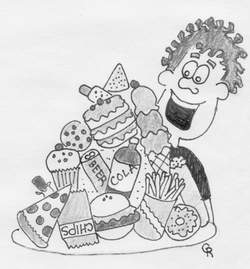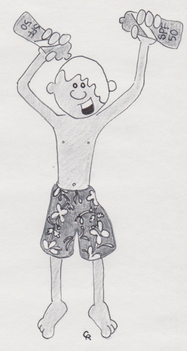
Measure your waist. Is it getting smaller? Look at how your clothes fit. If you're seeing a change, stay with it. You are making progress.
| Mary-Jo Murphy, MS, RN, CDE, certified diabetes educator |
|
 Recently one of my readers commented that she is "eating healthily, but the weight isn't coming off." This person didn't give herself credit for the fact that she is also exercising and has become much more toned. In other words, her adipose tissue is turning into muscle, and muscle weighs more than fat. Don't get all your information on your progress from one source - your scale. Measure your waist. Is it getting smaller? Look at how your clothes fit. If you're seeing a change, stay with it. You are making progress.
3 Comments
 When considering behavioral change, I am reminded of the title of a book by Bill Hogan: How Do You Eat An Elephant? One bite at a time! Maybe you can relate. You have every intention of being healthier. You join a gym. You even buy expensive running shoes. They sit unused, because you hate to run. Most nights, you get home too late from work to use your membership. Besides, your kids need help with their homework. Your wife cooks your favorite dessert. How can you resist? Fast food restaurants call out to you. And, let’s face it; you’re hungry all the time. You tell yourself, I’ll start first thing tomorrow. But your alarm doesn’t go off. You grab a cup of coffee, and someone at work has brought in doughnuts. Another week, month, year goes by, and eventually your calendar reminds you of the return appointment to your doctor. You rush out to buy vegetables and fruit. Your stuff yourself on plain yogurt and celery sticks and hope your doctor won’t notice the ten-pound weight gain. “I'll do it, Doc. This is a wake up call.” But what you really want to say is, “Do you have any idea how hard it is to lose weight? Do you know how much I hate exercise? I have a life, you know. This is a very bad time to ask me to do these things, to cut out the sweets, the rich foods. It's my birthday or vacation time or holiday time or summertime, springtime...” You just want to get out of there. As he’s writing the prescription, you sneak a look. Under that lab coat you see a little flab around his middle. Secretly, you feel vindicated. I have a friend who when faced with a delicious, chocolate chip cookie would tell me, “We’re all going to die anyway, so why not enjoy ourselves?” The same friend would remind me with nostalgia of lovely figure she “used to have.” Aware of current styles, she anticipated the next season, by which time she would have “lost 10 or 20 pounds.” I felt compelled to offered fact-based, boring, medical information as to why taking charge of her weight would be a good idea: family history of diabetes, risk of high blood pressure, increased energy and a family who needed her to be a healthy role model. When she’d glaze over, I’d remind her how cute she’d look in those new jeans we’d seen at the mall. She continued to eat cookies, but I felt hopeful. I knew something she didn’t. She was on the brink of change. She had already progressed into the second stage of Behavioral Change, the Contemplative Stage. If you are reading this, you are likely way ahead of those Pre-Contemplative types, who haven’t given Preventative Health a thought. If you are thinking of or talking about losing weight, giving up smoking, taking up exercising, going for regular mammograms, anything healthful, be hopeful. Sometime in the future you will replace intention with action? My friend was partially right. If we allowed our human condition to overwhelm our consciousness, we might just stay in bed, eat bon-bons, and wait for the end to come. But miraculously we choose to get up every morning. We affirm life and our desire to make things better. We get on with it. We offer our talents and efforts at work or school or home. We look forward to having fun. We love and are loved back. We balance that sense of futility with hope. So how did contemplation move my friend into the next stage, A Plan? One day a couple of her friends showed up at her door for an evening walk. She took a tiny bite of the elephant. Her friends showed up another night, and she went for another walk. They showed up another night, and she went for another walk. Another night, she went for another walk… Before she knew it, she was walking regularly. Those lovely endorphines secreted during exercise, hormones that make us feel happy and content, kicked in. Her contemplation took the form of a plan. Her plan became a habit. Initially, she was huffing and puffing. Now she keeps up. When she looks in the mirror, she notices she is more fit. She discovered what was in it for her to change. Her positive self- image re-emerged. She saw that as a healthier person, she might have more years with her children and grandchildren. Her energy came back. In the process her blood pressure improved. Then, she discovered dancing, and found she was good at. People started to tell her how fantastic she looked. Caught in the loop of life-affirming experiences, her new habits became part of her life. She still eats cookies, but she finds enjoyment in other things too. She has moved into the next stage of Behavioral Change, Maintenance. This week, take a nibble. Contemplate. And while you do, walk around the block or up a flight of stairs. Ask yourself: If I had a plan, what, if anything, would I be willing to do today?  For some, memories of last year’s Ventura County Fair may include a concert from a group that was all about the romance of surfing, the beach and the sun. Anyone attending the concert probably noticed that the damage done the audience’s collagen by sunbathing so many years ago has taken its toll. Those of us who hummed along with The Beach Boys to The Warmth Of The Sun are starting to show the effects of those carefree days. Many of us look more like California Raisins than The Girl From Ipanema. As June Gloom burns off, I feel compelled to offer a few thoughts on UV rays. For millions of years our prehistoric ancestors had dark skin. Too much ultraviolet radiation destroys the body’s Folic acid, which is crucial for embryonic development. The brown pigment or melanin in the skin is a defense. It dissipates the energy into harmless heat and blocks the UV from damaging the skin’s DNA. 70,000 to 100,000 years ago, when Homo sapiens began moving north where there was less sun, a mutation toward light skin allowed for more absorption of Vitamin D, which was also essential. We all know the rest of the story, but if you don’t, I’ll fast forward to the part that has to do with Gidget and the Beach Boys. 50,000 years later, surfer girls and guys found that exposure to the sun’s rays caused their skin to darken. Not only did this darkening continue to protect from absorbing too many ultraviolet rays, but in modern times, it became a standard of beauty. Then years later the bad news became apparent; too much time in the sun caused not only uncomfortable redness but also premature aging and worse yet, skin cancers. So someone invented sunscreen, and that should have been the happily-ever-after. We dutifully slathered our kids and ourselves with confusing concoctions, as we tried to interpret such terms as: SPF, UVA, UVB, Waterproof, Sweatproof and Sunblock. “Rays,” you say. “I’m just catching a few. As long as I wear my sunscreen, I’m safe. Right?” Maybe. It always has to get complex. That’s what science is about, making things more complicated before they become safer. Researchers found that our sun dishes up two kinds of rays, the UVB, ultraviolet B or short rays, which cause sunburn and some skin cancers, and the more penetrating UVA, ultraviolet A or long rays that pose the greatest risk of skin cancer, premature aging and melanoma. These sneaky rays do not cause redness and can be absorbed through your car window. Not all sunscreens protect against them. An article in the magazine Cure Today 2006, tells us that sunscreen strength is determined by SPF, Sun Protection Factor against UVB rays. So if it’s labeled SPF 15, it means it takes the skin 15 times longer to begin turning red than it would if you went out not wearing any. Of course, how much protection you need varies depending on whether your relatives are from Helsinki or Havana. Experts recommend SPF between 15 and 30. They also suggest reapplying every few hour and putting it on 30 minutes before going in the sun, as the stuff needs time to bind with the skin. Good advice! When was the last time you tried to get your kid out of the water to apply sunscreen? When was the last time you stopped a tennis match because you had sweated off your sunblock? The FDA has gotten stricter about what testing is required to label the sunscreen Broad Spectrum (protects against both types of rays), and waterproof or sweatproof, because these terms are misleading if not altogether false. Next year’s labels will say water-resistant instead, and the companies will have to let you know how long you can swim or sweat before losing the protection. It’s promised that by the time the 2012 Fair rolls around, the FDA will have seen to it that we not only know what SPF we are buying but which rays the white goopy stuff is blocking and for how long. Last year the FDA approved Zelboraf, a melanoma treatment that can target 50 % of these malignant tumors. This is great news! From Connecticut to California, as we start to enjoy some of the warmest and sunniest days of the year, please continue to slather. Prevention is preferable. |
AuthorMary-Jo offers sage advice. Archives
September 2021
Categories
All
|